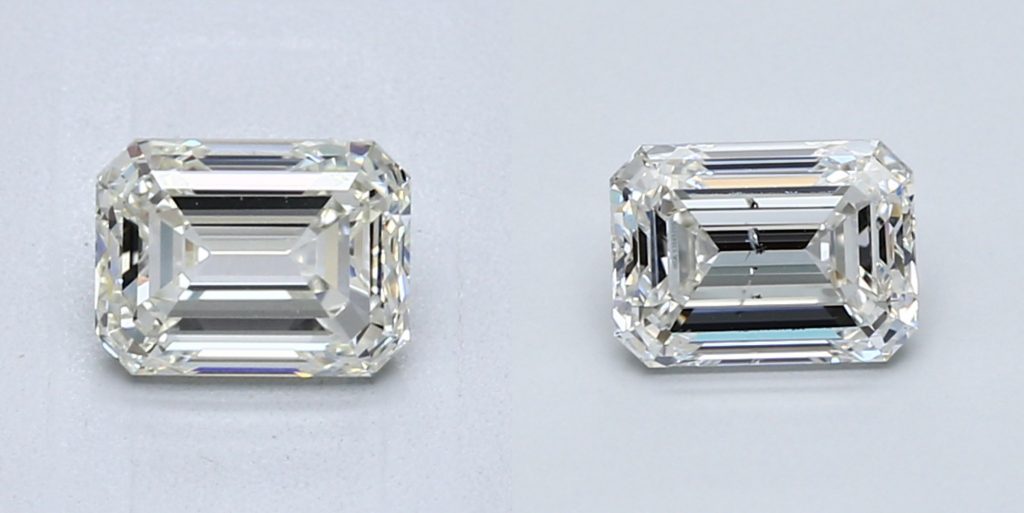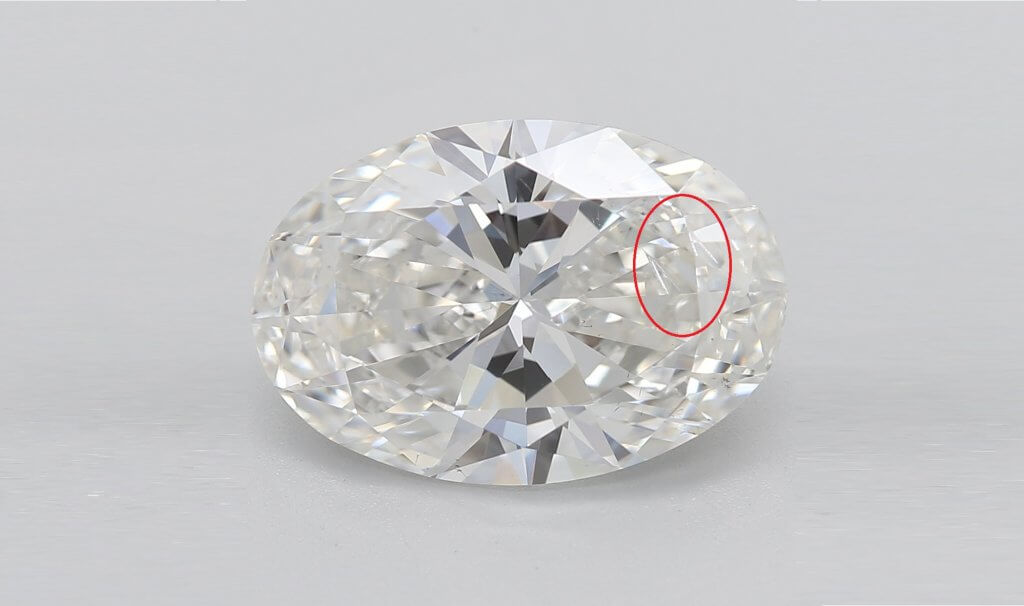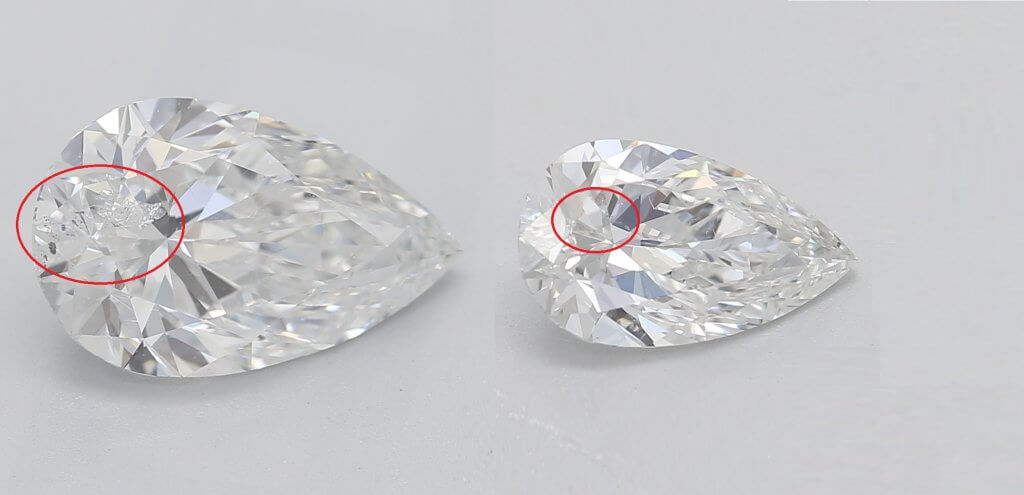Eye Clean Diamonds: The Ultimate Balance In Clarity
Key Takeaways
- If you are in the midst of a search for an engagement ring, then the chances are you have heard the words ‘eye-clean’ bandied about quite frequently.
- Determining eye cleanliness can be done by holding the diamond 6-12 inches from your face, looking at the diamond face-up.
- If no blemishes are visible, whether that be cloudiness, marks or inclusions, then the diamond is eye clean.
- This is why it is so important to visit your jeweler and see the diamonds up close and personal. This way, you will have a far better idea of whether a diamond is eye-clean, which is important when it comes to getting that perfect engagement ring for the future bride.

It doesn’t take a lifelong diamond enthusiast to confirm that, whenever the subject is on the cards, the phrase ‘eye clean’ is never very far from anyone’s lips.
And, while it might sound self-explanatory at first, it can be a little confusing to work out how much of an emphasis you want to place on it, when so much of your attention is being pulled toward the Four Cs instead. Fortunately, there is a way of using your knowledge about the Four Cs alongside your understanding of eye cleanliness – and it’s the secret to finding the perfect diamond for your engagement ring.
An eye clean diamond is a diamond that appears flawless to the naked eye from a short distance (about 6-12 inches). It may contain imperfections, though, that are visible only under magnification. They have a high value, but remain much, much lower in price than flawless diamonds – and that’s precisely why you’ll want to hold it front and center in your mind going forward.
Diamond Clarity
As you no doubt know, diamonds are graded on their 4 Cs: color, cut, carat and their clarity. The clarity of a diamond is graded based on its appearance under 10x magnification, the significance of any inclusions or blemishes under magnification and the naked eye, and how many inclusions or blemishes it has.
A diamond’s clarity will have a significant impact on its value and overall price.
The diamond clarity scale devised by the GIA contains the following grades:
- Flawless (FL)
- Internally Flawless (IF)
- Very Very Small Inclusions 1 (VVS1)
- Very Very Small Inclusions 2 (VVS2)
- Very Small Inclusions 1 (VS1)
- Very Small Inclusions 2 (VS2)
- Small Inclusions 1 (SI1)
- Small Inclusions 2 (SI2)
- Inclusions 1 (I1)
- Inclusions 2 (I2)
If you’re wondering why a grade specifically for eye clean diamonds is missing from the clarity scale, you wouldn’t be the first. However, eye clean diamonds are present throughout the clarity spectrum – barring the very lowest grades – and can be found in various grades, such as SI1 or VS2.
FAQ
How Can You Determine if a Diamond is Eye Clean?
There is a very simple way to check if a diamond is eye clean or not: look at it!
Hold the diamond around 6-12 inches away from your face, looking at the diamond face up. Move the diamond slowly back and forth, and if you don’t see any blemishes – such as cloudy white areas, black spots, cracks, white spots, or strange lines – then the diamond is eye clean.
Of course, you can’t do this through a computer screen – and that’s one of the main reasons why we urge all our readers to find a local jewelry store where they can view their diamond before making the commitment.
Yes, in the beginning, you might find yourself second-guessing your own judgement, but this is where picking an expert and reputable jeweler who can weigh in with their own appraisal will pay off.

Why is it Important to Find an Eye Clean Diamond?
For two reasons. First of all, to ensure the most beautiful diamond possible, and to avoid ruining your engagement ring with visible inclusions. Secondly, to make sure that you’re not overpaying for features that won’t be visible once the diamond is away from the jeweler’s magnifying glass.
We mentioned above that flawless diamonds are super valuable. They’re rare and, to the right collector, fascinating enough to demand a price that would seem much too high to the rest of us.
For the casual shopper looking to create a beautiful engagement ring (or any other piece of jewelry), there’s simply no point in paying that much money, since identifying any real difference between a flawless diamond and an eye clean diamond requires strong magnification and, potentially, a skilled eye. A small diamond with IF clarity won’t look as impressive as a larger, eye clean diamond, even if that diamond had a clarity grade as low as VS2 or SI1.
Essentially, focusing on eye cleanliness is your ticket to finding the biggest and most beautiful diamond in your price range.
Are VS2 Diamonds Eye Clean?
In most cases, yes. While a VS2 diamond, a diamond with a GIA clarity grading of Very Small Inclusions 2, does indeed have very small inclusions, VS2 diamonds are almost always clean to the naked eye.
As you might have guessed by now, there is no definitive cut-off point on the GIA clarity scale where diamonds can no longer be eye clean. Smaller SI1 diamonds can be eye clean, while larger VS2 diamonds won’t be. Some shapes, like the Emerald, will offer a little less leeway than, say, the Round or Cushion cut.
According to GIA standards, diamonds that are graded Flawless (FL), Internally Flawless (IF), Very, Very Slightly Included (VVS1 and VVS2) and Very Slightly Included (VS1 and VS2) are considered eye clean, which offers plenty of options to any shopper.
Your Guide to Buying an Eye Clean Diamond
When purchasing an eye clean diamond, it is important to buy the lowest clarity diamond that is still eye clean. For most people, this means starting at a grade of around SI2 or SI1, and adjusting depending on the size and shape of diamond you’re looking more.
First, Do Your Research
While the internet is not the place to appraise the eye cleanliness of diamonds, it is the best place to get your facts straight before you start seriously shopping around. Read up about all of the Four Cs, start browsing diamonds, then go see them for yourself at your trusted local jewelry store.
Talk To Your Jeweler
Part of the benefit to working with a jeweler you truly trust is being able to lean on decades worth of experience, and to feel confident that they won’t steer you wrong, or ‘forget’ to mention certain features that may not seem glaringly obvious to you at first.
Talk the diamond’s GIA report through with them. It will contain a ‘plot’, onto which each inclusion will have been carefully mapped. This is a great way of getting to know the diamond in front of you, and of making sure it’s truly eye clean.
See for Yourself…
- Step 1: Look at it! Hold the diamond around 6-12 inches away from your face, looking at the diamond face up.
- Step 2: Move the diamond slowly back and forth.
- Step 3: If you see blemishes, the diamond is NOT eye clean
- Step 4: if you don’t see any blemishes: cloudy white areas, black spots, cracks, white spots, or strange lines the diamond is eye clean.
So, Should You Worry About Eye Cleanliness?
Eye cleanliness is definitely worth a lot of attention, yes. It’s all too easy for an otherwise beautiful diamond to be totally ruined by a major inclusion, and a diamond like that is not worth paying for.
In an ideal world, it would be possible to cut inclusions away from any diamond, and to still have a beautiful stone by the end of it. In reality, however, it’s just not possible. In some rough stones, the arrangement or size of the inclusions mean that cutting them away is impossible, or that doing so would yield a very, very small diamond.
This works for some people but, in an engagement ring, where all attention is pointed toward that stone at its center, a visibly included diamond is not worth the minor savings involved. Eye clean diamonds are available at most of the clarity grades, meaning that they’re available at practically any price point – and by far the best bet for you.

Sep 24, 2021 By Willyou.net
The Surprising Facts About Diamond Feathers

Mar 17, 2022 By Willyou.net
Avoiding Diamond Inclusions: The Key To Clarity








